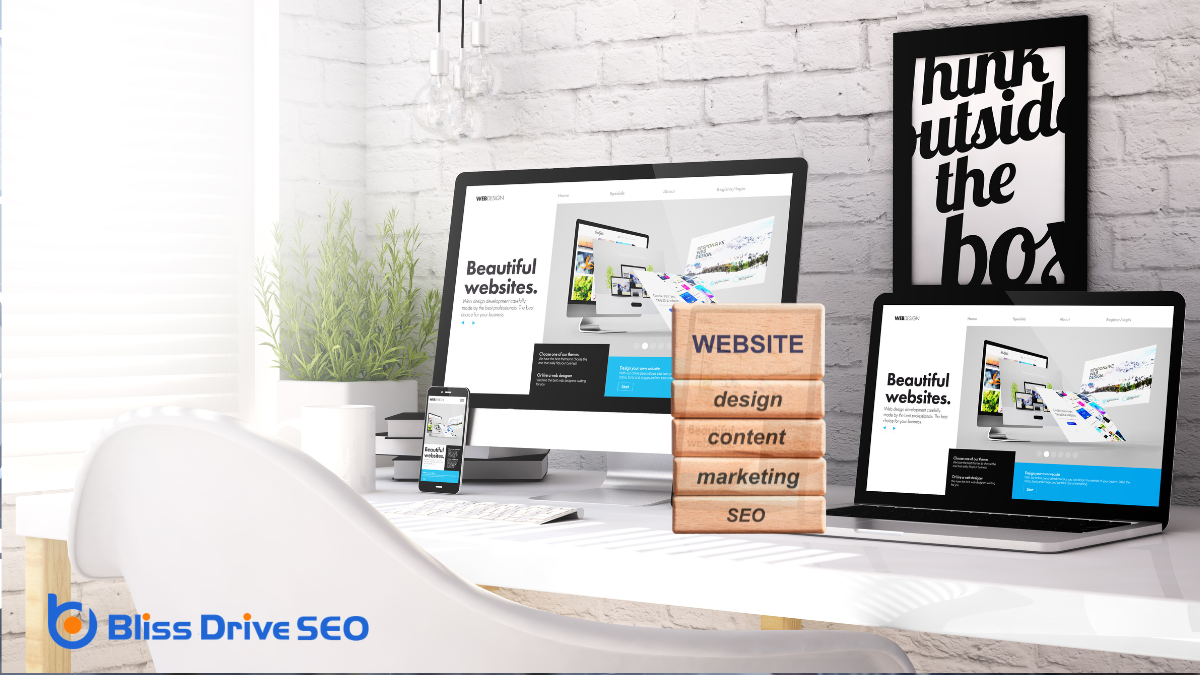Digital Marketing Services
Learn More About Us

When you're thinking about developing a website, the first step is setting clear objectives that align with your target audience's needs. You've got to choose a domain nameThe address of a website, crucial for branding and SEO. that not only resonates with your brand but is also memorable. Once that's settled, selecting the right web hosting service becomes essential, as it directly impacts your site's performance and security. But what about the design and content that will capture and retain visitors' attention? And how do you guarantee everything runs smoothly before going live? These are the questions that will guide you through the process.
Initiating your website journey begins with an essential step: defining your website goals. Without clear goals, you might find yourself lost in a sea of endless possibilities.
Start by asking yourself what you want to achieve with your website. Are you looking to showcase your portfolio, sell products, or perhaps create a blog to share your insights? Understanding your purpose helps shape every decision you make moving forward.
Once you've pinpointed your main objective, it's time to think about your target audience. Who are they, and what do they need from your site? By identifying your audience, you can tailor your content and design to meet their expectations, making your website more effective and engaging.
Don't forget to set measurable goals. Whether it's increasing traffic, boosting sales, or gaining subscribers, having specific targets helps you track your progress and make necessary adjustments.
Remember, your goals should be SMART: Specific, Measurable, Achievable, Relevant, and Time-bound.
Defining your website goals isn't just about what you want to achieve; it's also about understanding the journey you're about to undertake and preparing to meet the needs of your audience.

Picking out the perfect domain name is an essential step in establishing your online presence. It's the first impressionWhen an ad is displayed on a user’s screen. people get of your site, so make it count. A great domain name is memorable, easy to spell, and reflects your brand or the purpose of your website.
Here's how you can choose the right one:
Choosing the right domain name sets the stage for your website's success. Take your time, be creative, and verify it aligns with your brand identity.
An essential step in launching your website is choosing a reliable web hosting service. This service stores your website's files and makes them accessible to users online. Start by considering your website's needs. Are you expecting high traffic? Do you plan to use lots of multimedia? These factors influence the type of hosting you should select.
Shared hosting is budget-friendly and suitable for smaller sites. If you're expecting more traffic, consider VPS (Virtual Private Server) hosting, which provides more resources and control. For large-scale operations, dedicated hosting offers a server entirely for your use. Cloud hosting is another flexible option, ideal for handling traffic spikes.
Next, evaluate the hosting provider. Look for uptime guarantees, as downtime can cost you visitors. Check customer supportServices provided to assist customers before, during, and after a purchase to ensure a positive expe... availability—24/7 support is a must. Research reviews to gauge reliability and user satisfaction. Confirm the provider offers easy scalability so you can upgrade as your site grows.
Security features are essential. Verify they offerThe specific product or service being promoted by affiliates. SSL certificates, firewalls, and backup options to protect your data.
Compare pricing plans, but don't compromise on quality for cost. By selecting the right web hosting service, you set a strong foundation for your website's success.
When designing your website layout, start by choosing a color scheme that aligns with your brand and creates the right mood for your audience.
Next, arrange content blocks in a way that guides visitors through your site logically and keeps their attention.
Balance aesthetics with functionality to guarantee a seamless user experience.
Selecting the right color scheme for your website is essential, as it sets the tone and affects user experience. Colors evoke emotions and create an atmosphere that can either draw users in or push them away.
To choose the perfect color scheme, consider your brand identity and the message you want to convey. Here's how you can select a color scheme that enhances your website's appeal:
Now that you've chosen a color scheme that resonates with your brand, it's time to focus on arranging content blocks to create an effective website layout. Start by identifying the key elements you want to include on your site, such as headers, images, text, and calls to action. These elements should guide visitors through your site's story.
Think about the hierarchy of information—what's most important for your visitors to see first? Place critical content, like your main message or product offerings, prominently on the homepage. Use visual cues like larger fonts or contrasting colors to draw attention.
Next, make sure your layout is intuitive. Visitors should easily navigate through your site without confusion. Use grids to maintain structure and balance, keeping the design clean and professional.
Consider how each section flows into the next, ensuring a seamless shift for users.
Don't forget mobile users. Test your layout on various devices to make certain it's responsive. A well-arranged layout adapts beautifully to different screen sizes, enhancing user experience.

As you develop your website content, focus on crafting engaging headlines that grab attention and draw readers in.
Make sure to optimize your content with SEO keywords to improve your site's visibility on search engines.
Balancing creativity with strategic keyword placement will help you attract and retain more visitors.
Crafting engaging headlines is essential for drawing readers into your website content and keeping them interested. A fascinating headline acts as a gateway, compelling visitors to click and explore further. It's your first opportunity to make a strong impression, so make it count.
To create headlines that resonate, consider these tips:
Releasing the potential of your website starts with optimizing SEO keywords; they serve as the bridge between your content and your audience. When you choose the right keywords, you increase the chances of your website appearing in search engine results, drawing more traffic.
Begin by researching the words and phrases your target audience uses. Tools like Google Keyword Planner or SEMrush can help identify these terms' popularity and competitiveness.
Once you've got your list, incorporate those keywords naturally into your content. Don't overstuff them; aim for a seamless integration that reads well and maintains your content's quality. Your primary keyword should appear in your title, headings, and throughout the text, but make sure it fits contextually.
Keep an eye on keyword trends, as they can shift. Regularly review and update your keyword strategy to stay relevant.
Also, consider using long-tail keywordsLonger, more specific keyword phrases that are less competitive and often more targeted., which are longer and more specific phrases. They might've lower search volumes but often attract more targeted traffic.
After all your hard work, it's now time to bring your website to life by testing and launching it. This vital step guarantees everything functions smoothly and delivers a great user experience. Here's a straightforward guide to help you through the process:
1. Conduct Thorough Testing: Before launching, test every aspect of your site. Check links, forms, and interactive elementsElements that require user interaction, such as buttons, forms, and sliders.. Make sure your website is responsive and looks good on all devices and browsers.
It's important to identify and fix any bugs or issues.
2. Optimize Performance: Speed is key for user satisfaction. Use tools like Google PageSpeed Insights to examine your site's load times.
Optimize images, enable compression, and consider a Content Delivery Network (CDN)A system of distributed servers that deliver content to users based on their geographic location. to improve performance.
3. Secure Your Site: Protect your visitors' data by securing your site with an SSL certificate.
Regularly update plugins and themes to prevent vulnerabilities. A secure site builds trust with your audience.
4. Launch and Monitor: Once everything checks out, it's launch time! Make your site live and share it with the world.
After launching, keep an eye on analyticsThe systematic computational analysis of data or statistics to gain insights and support decision-ma... to understand user behavior and make necessary adjustments for improvement.
You've got the roadmap to develop a successful website. Start by setting clear goals and knowing your audience. Pick a catchy domain name and secure, reliable hosting. Design a user-friendly layout and craft engaging, SEO-optimized content. Before you go live, thoroughly test everything to guarantee a smooth launch. Once your site is up, keep an eye on analytics to make continuous improvements. With these steps, you're on your way to creating an effective online presence.
